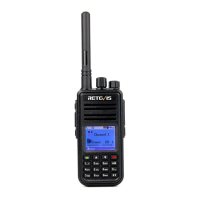
Do you have a question about the Retevis RT3 and is the answer not in the manual?
| Channels | 3000 |
|---|---|
| Output Power | 5W |
| Battery Capacity | 2000mAh |
| Operating Voltage | 7.4V |
| Battery Type | Li-Ion |
| Antenna Impedance | 50Ω |
| Waterproof Rating | IP54 |
| Range | 3-5 km |
| Frequency Range | 400-470MHz |
| Dimensions | 131 x 61 x 36 mm |
Details the operating system, hard disk, and memory needed for software.
Instructions for installing the driver for the programming cable.
Steps for installing the programming software and preparing the computer.
Steps to prepare the walkie-talkie and connect the programming cable.
Guide on using the software to read, modify, and write frequencies.
Troubleshooting common issues encountered during frequency programming.
Solutions for when the radio does not power on or has short battery life.
Troubleshooting problems with communicating with other transceivers or hearing other groups.
Addresses signal reception issues and persistent noise or static interference.
Provides essential instructions and warnings for safe radio operation.
Instructions for unpacking the radio and verifying supplied accessories.
Guide for installing and removing the battery and other accessories.
Step-by-step instructions for charging the radio's battery.
Notes on charging, indicators, and precautions for optimal battery performance.
Guidance on antenna types and their effect on communication range.
Detailed steps for attaching and detaching the battery from the radio.
Instructions on how to securely attach and detach the radio's antenna.
Instructions for connecting an external headset or microphone to the radio.
Introduces radio components, safety precautions, and general overview.
Description of key radio components like antenna, LED, speaker, microphone, and knobs.
Explains how to select a channel group (zone) for communication.
Steps for receiving and responding to group communications.
Instructions for handling one-on-one calls, including presence testing.
Methods for initiating group or single calls using the channel knob.
Utilizing pre-programmed keys for quick group or single call initiation.
Procedures for receiving and acknowledging an emergency call alert.
Steps to respond to an incoming emergency call.
Functionality to send emergency calls to other radios after confirmation.
How to use voice activation for emergency calls with hands-free transmission.
Explains inputting text, user aliases, and IDs using keypad modes.
General guidance on navigating and using the radio's menu system.
Procedure to check if other radios are active within the system.
Function to open the target radio's microphone for monitoring sounds.
Steps to initiate a single call using the contact list.
Viewing recent incoming, outgoing, and missed call records.
Handling and viewing missed call notifications on the radio.
Saving contact information from missed calls.
Procedure for removing entries from the call log history.
Managing text messages, including sending, receiving, and editing.
Process for sending received messages to another user or group.
Features for viewing, resending, or deleting previously sent text messages.
Managing received text messages, including reading, replying, and deleting.
Steps to remove individual text messages from the inbox.
Procedure to clear all received messages from the inbox.
Enabling encryption to prevent unauthorized eavesdropping on communications.
Functionality for operating the radio using Dual Tone Multi-Frequency signaling.
Activating or deactivating radio functions, e.g., disabling a stolen radio.
Steps to remotely disable a specific radio using its alias or ID.
Managing scan lists, including adding channels and setting priority.
Configuration options for radio behavior, including talkaround, tones, and power.
Accessing information such as radio ID, name, and firmware versions.
Editing channel contents like frequency, name, and CTCSS/DCS settings.
Enabling or disabling all radio tones and prompts, except emergency alerts.
Activating or deactivating tone feedback for keypad inputs.
Setting the transmit power level to high or low for different communication ranges.
Turning the screen and keyboard backlight on or off, with time-out options.
Adjusting the squelch level to filter low-signal calls or background noise.
Enabling or disabling the display of the boot screen when the radio starts.
Preventing accidental key inputs by locking the keypad manually or automatically.
Selecting the display language for the radio interface from available options.
Activating or deactivating the radio's LED indicator light.
Using voice activation for hands-free calls without pressing the PTT button.
Setting and managing a password to secure the radio and control power-on access.
Configuring the radio's time and date settings.
Selecting between Channel Mode (CH) and Memory/MR Mode for radio operation.
Accessing information such as radio ID, name, and firmware versions.
Editing channel contents like frequency, name, and CTCSS/DCS settings.
Setting the receiving frequency for a specific channel.
Setting the transmitting frequency for a specific channel.
Assigning a custom name to a radio channel.
Configuring the Time-out Timer to limit transmission duration.
Setting up CTCSS and DCS codes for analog channel privacy.
Configuring CTCSS/DCS encoding and decoding for channel access.
Setting the color code for digital channels to manage group communications.
Assigning repeater slots for digital channels to manage transmissions.
Technical details including frequency range, channels, voltage, and battery.
Performance metrics for the radio's transmitting capabilities.
Performance metrics for the radio's receiving capabilities.
Information on warranty coverage, limitations, and service procedures.